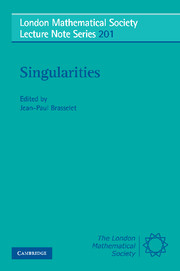Book contents
- Frontmatter
- Contents
- Introduction
- Plenary Conferences
- Specialized Conferences
- List of participants
- On Complex Projective Hypersurfaces which are Homology-Pn's
- Generic Geometry and Duality
- An arithmetical factorization for the critical point set of some map germs from C2 to C2
- Trivializations of stratified spaces with bounded differential
- Moduli for Singularities
- Conormal space and Jacobian modules: A short dictionary
- Weak Lefschetz and Topological q-Completeness
- Volumes and lattice points - proof of a conjecture of L. Ehrenpreis
- Connexions méromorphes
- Deformations of maps on complete intersections, Damon's Kv-equivalence and bifurcations
- Cycles évanescents et faisceaux pervers II: cas des courbes planes réductibles
- A Desingularization Theorem for Systems of Microdifferential Equations
- Topological Stability
- Boundary Fronts and Caustics and their Metamorphoses
- Quid des stratifications canoniques
- Irrégularité des revêtements cycliques
Boundary Fronts and Caustics and their Metamorphoses
Published online by Cambridge University Press: 05 May 2013
- Frontmatter
- Contents
- Introduction
- Plenary Conferences
- Specialized Conferences
- List of participants
- On Complex Projective Hypersurfaces which are Homology-Pn's
- Generic Geometry and Duality
- An arithmetical factorization for the critical point set of some map germs from C2 to C2
- Trivializations of stratified spaces with bounded differential
- Moduli for Singularities
- Conormal space and Jacobian modules: A short dictionary
- Weak Lefschetz and Topological q-Completeness
- Volumes and lattice points - proof of a conjecture of L. Ehrenpreis
- Connexions méromorphes
- Deformations of maps on complete intersections, Damon's Kv-equivalence and bifurcations
- Cycles évanescents et faisceaux pervers II: cas des courbes planes réductibles
- A Desingularization Theorem for Systems of Microdifferential Equations
- Topological Stability
- Boundary Fronts and Caustics and their Metamorphoses
- Quid des stratifications canoniques
- Irrégularité des revêtements cycliques
Summary
Abstract In this paper the subsequent wavefronts and caustics generated by an initial wavefront which is a surface with boundary are studied. It appears that such boundary fronts and caustics are connected with boundary singularities (i.e. singularities of functions on a manifold with boundary) in the same way as usual fronts and caustics are connected with the usual singularities of functions.
Boundary fronts and caustics are described in terms of generating families of corresponding objects in contact and symplectic spaces. These objects are pairs of Legendrian and Lagrangian submanifolds. In two- and three-dimensional spaces, the stable singularities of boundary fronts and caustics are classified and metamorphoses of simple singularities of boundary fronts and caustics are described.
INTRODUCTION
In this paper we study the subsequent wavefronts and caustics generated by an initial wavefront which is a surface with a boundary.
Wavefronts and caustics created by radiating surfaces without boundary have been studied in many papers (for references see [4]). In particular Arnold established a connection between their singularities and singularities of functions in [2]. Singularities of wavefronts and caustics in spaces of dimension < 10 were classified in [9]. The papers [1], [10] are devoted to an investigation of bifurcations (or metamorphoses) in families of wavefronts and caustics.
If the radiating surface has boundary, new singularities arise. The resulting wavefronts and caustics are then called boundary fronts and boundary caustics. The boundary front has two components which correspond to the surface and its boundary respectively.
- Type
- Chapter
- Information
- Singularities , pp. 363 - 374Publisher: Cambridge University PressPrint publication year: 1994



